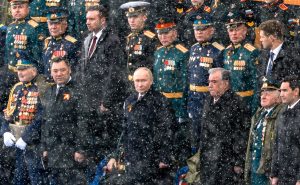For the second year in a row all five Central Asian presidents joined Russian President Vladimir Putin in Moscow for the annual Victory Day parade on May 9. Their appearance in Red Square flanking Putin as the rain came down, a tank rolled by, and thousands of soldiers marched through underscores their ongoing linkages, both economic and political, to Russia.
But the trip to Moscow also presented an opportunity for Central Asian leaders to bring matters of concern directly to Putin. It attests to the dual nature of the relationship: Russia needs Central Asia as well.
Kyrgyzstan is a case in point. Kyrgyz President Sadyr Japarov raised the issue of labor migration in his remarks in the Eurasian Economic Union (EAEU) meeting that took place on May 8.
The EAEU’s Supreme Eurasian Economic Council met to mark the grouping’s 10th anniversary on May 8. The EAEU’s leaders met first, including Russian President Vladimir Putin, President Alexander Lukashenko of Belarus, Kazakh President Kassym-Jomart Tokayev, Kyrgyz President Sadyr Japarov, and Armenian Prime Minister Nikol Pashinyan, as well as Chairman of the Board of the Eurasian Economic Commission Bakytzhan Sagintayev.
An expanded meeting included EAEU observers Uzbek President Shavkat Mirziyoyev and Cuban President Miguel Diaz-Canel Bermudez. Secretary General of the Commonwealth of Independent States Sergei Lebedev was also in attendance.
Elvira Aidarkhanova described the EAEU in an article for The Diplomat last year as “a relatively successful geopolitical project for Russia” but also “an ineffective instrument in terms of economic cooperation and integration, paradoxically its very reasons for being.”
The EAEU’s treaty was signed in late May 2014 by Belarus, Kazakhstan, and Russia. The initiative, which grew from various economic projects in the former Soviet space, was inspired by then-Kazakh President Nursultan Nazarbayev. As far back as 1994, Nazarbayev had suggested forming a “Eurasian Union” to bridge regional trade between Asia and Europe. The EAEU’s treaty came into force on January 1, 2015; Kyrgyzstan and Armenia joined that year.
The organization’s expansion halted there. In recent years, both Tajikistan and Uzbekistan flirted with membership, but neither has pursued it fully quite yet – the latter is an observer, however.
The EAEU’s economic benefits (or lack thereof) have been exhaustively discussed elsewhere. There is, however, indisputable political value in membership – both for Russia and the Central Asian members. For Russia, the EAEU provides a ready roster of leaders to meet with and extends Russia’s economic interests and norms into a wider political space. It’s no accident that while Armenia is the EAEU’s chair this year, the group often meets in Moscow in May – this time on the day between Putin’s fifth inauguration on May 7 and the nationalistic fanfare of May 9. While technically, Pashinyan was the meeting’s chair, and speakers addressed their remarks to him, the the gravity invariably pulled toward Putin.
In his remarks at the meeting, Kyrgyz President Japarov raised the issue of “mobility of labor resources.”
“For the Kyrgyz Republic, issues of worker mobility are of fundamental importance, and therefore we call on you to prevent violations or deterioration of the provisions of the Treaty on the EAEU. We must not allow serious damage to the image of our association. It is necessary to strengthen the trust of our citizens and continue to work on the formation of a single labor market,” Japarov said.
His remarks were addressed to the chair, but it was Putin’s ears the statement was for.
Since the March 22 Crocus City Hall attack, several Central Asian states – Kyrgyzstan first and most recently Tajikistan – have warned their citizens against migration to Russia. Kyrgyzstan and Tajikistan are among the world’s most remittance dependent countries, and Russia is a major destination. Indeed, labor mobility to Russia was a major motivational factor in Kyrgyzstan’s decision to join the EAEU.
While the remarks shared are just one small instance, they hint at a larger reality: EAEU membership provides a venue for Kyrgyzstan to bring up its concerns, much the way attending the May 9 parade provides Central Asian leaders with facetime with Putin. It’s possible (and likely) that the issue of labor migration was also raised by Tajik President Emomali Rahmon. That Kyrgyzstan published Japarov’s speech and Tajikistan has said very little about what, if anything, was discussed in Moscow illustrates, in part, differences between the two when it comes to communications policies and the relative degrees of openness. But in these moments, all the opacity aside, we can see the ways in which it is Russia that is reliant on Central Asia – flipping the traditional script in which the Central Asian states are merely subservient to Moscow.
Nothing particularly significant was agreed upon at the EAEU meeting. The documents signed included one authorizing the start of negotiations with Mongolia on a “temporary trade agreement” and an electronic information agreement with Vietnam.
Armenian Prime Minister Pashinyan did not stick around for the Victory Day parade, illustrating Armenia’s own divergent, often difficult, and evolving relationship with Moscow.

































